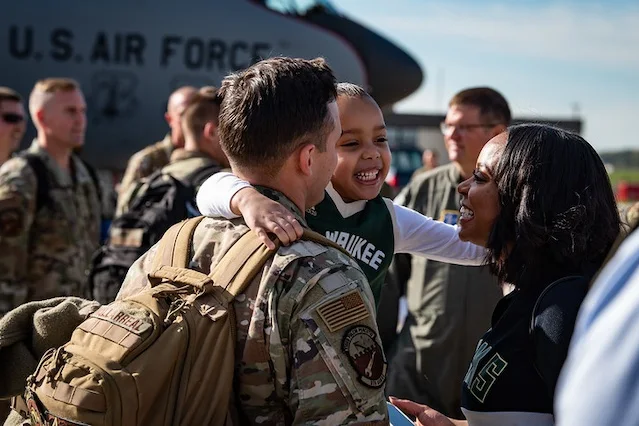By: Leanne K. Knobloch, PhD
Homecoming after deployment can be a day of excitement, relief, and joy for Service Members and their loved ones reunited after their time apart. But what happens next? After the “Welcome home” banner comes down, the confetti is swept up, and the gear is stowed away, how do military family members build a “new normal” after all the changes that happened during deployment?
My team and I conducted a study of Service Members and their spouses about 3 months after the Service Members had returned from deployment. We asked them to answer the question, “What advice would you give to other military families to help them with reintegration after deployment?” Here’s what they said:
Communicate effectively.
Talk openly and listen carefully during reintegration.
“Communicate, communicate, and communicate. You aren’t mind readers. Good, bad, or indifferent, you have to understand how your spouse and children feel about everything.” —deployed Army husband, age 29
“Communicate to the best of your ability. Be open about as much as possible so you both understand what the other expects of you and what you can expect from them.” —at-home Army wife, age 28
Be patient.
Take your time. Don’t rush the homecoming process.
“Ease back in.” —deployed Air National Guard husband, age 36
“Give him time to get back into the fold of the family. It takes time for kids to get used to Daddy being back. Allow him time to watch how the house has changed and how things are done and not to just jump in.” —at-home Army National Guard wife, age 36
Emphasize family.
Prioritize quality time together, even in the midst of other responsibilities clamoring for your attention.
“Make sure to leave time to spend together to get to know each other again. One-on-one time will help a lot.” —deployed Army husband, age 30
“Fight for good family and spouse time, no matter what it takes. Don’t fall victim to other priorities.” —deployed Air National Guard husband, age 42
Manage expectations.
Work together to develop a realistic understanding of what to expect during the transition from deployment to reintegration.
“Discuss any expectations that either spouse may have of the other.” —at-home Army National Guard wife, age 31
“Don’t come back expecting everything and everyone to be the same.” —deployed Army husband, age 41
Get help.
Don’t be afraid to ask for assistance, including help from military resources, civilian resources (such as the American Red Cross and Sesame Street programs for military families), and personal resources (such as friends and neighbors).
“Engage in family counseling. Make sure your children have a trusted adult to talk to outside of the home to address any feelings they have and may not be able to talk with you about. Make sure your soldier gets counseling even if it’s just to ‘check in’ with someone.” —at-home Army National Guard wife, age 38
“If your partner isn’t willing to go to counseling to figure out what’s wrong and to help you out, go without them and help yourself. It will help the relationship out before it ruins it.” —deployed Army National Guard husband, age 31
People typically prefer to receive advice from credible sources who have “been there” and walked a similar journey. In other words, this advice may be especially helpful because it comes from people who have been through the deployment process themselves. And because Service Members and at-home spouses gave their advice 60–90 days after reunion, their recommendations may work best during that same time frame.
This blog is based on a study by Leanne Knobloch, Erin Basinger, Erin Wehrman, Aaron Ebata, and Patricia McGlaughlin. It was published in the Journal of Family Communication.
Disclosure: The opinions and assertions expressed herein are those of the authors and do not reflect the official policy or position of USU or DoD. The contents of this publication are the sole responsibility of the authors and do not necessarily reflect the views, opinions, or policies of The Henry M. Jackson Foundation for the Advancement of Military Medicine, Inc. Mention of trade names, commercial products, or organizations does not imply endorsement by the U.S. Government. The authors have no financial interests or relationships to disclose.






